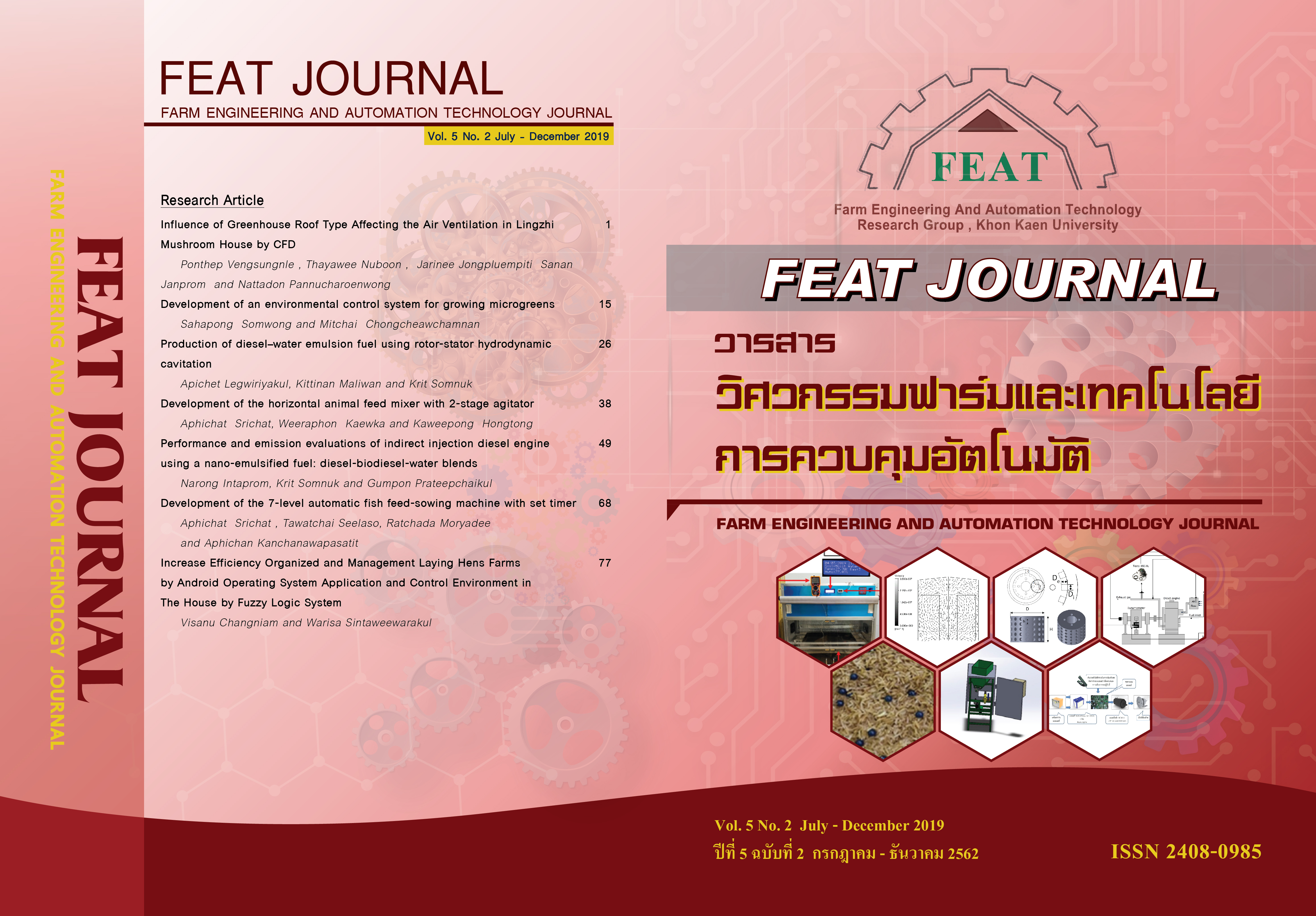การวิเคราะห์ประสิทธิภาพและการปลดปล่อยก๊าซของเครื่องยนต์ดีเซลแบบฉีดเชื้อเพลิงโดยอ้อมด้วยเชื้อเพลิงนาโนอิมัลชัน ดีเซล-ไบโอดีเซล-น้ำ
Main Article Content
บทคัดย่อ
งานวิจัยนี้มีวัตถุประสงค์เพื่อศึกษาสมรรถนะและการปลดปล่อยก๊าซที่ได้จากการเผาไหม้ของเครื่องยนต์ดีเซลที่ใช้เชื้อเพลิงอิมัลชันชนิดน้ำในน้ำมันระหว่าง ดีเซล-ไบโอดีเซล-น้ำ ด้วยการใช้คลื่นเสียงอัลตราโซนิกที่มีความถี่เท่ากับ 18 kHz เพื่อผลิตเชื้อเพลิงอิมัลชันในสัดส่วนปริมาณดีเซล 42 vol.% ไบโอดีเซล 50 vol.% น้ำ 2 vol.% และใช้สารลดแรงตึงผิวคือ Span80 และ Tween80 อัตราส่วนเท่ากับ 1:1 โดยทดสอบในเครื่องยนต์ Kubota รุ่น RT100 สูบเดียว ระบบฉีดเชื้อเพลิงแบบโดยอ้อม (indirect injection, IDI) ถูกนำมาใช้ทดสอบภายใต้ภาระโหลดเท่ากับ 0% 25% 50% 75% ที่ความเร็วรอบ 2300 rpm โดยบันทึกค่าการปลดปล่อยของก๊าซที่ได้จากการเผาไหม้คือ O2 CO2 CO HC NOx และทดสอบสมรรถนะของเครื่องยนต์คือ ค่าอัตราการสิ้นเปลืองเชื้อเพลิงจำเพาะ (specific fuel consumption, SFC) และค่าอัตราการสิ้นเปลืองเชื้อเพลิงเบรกจำเพาะ (brake specific fuel consumption, BSFC) ซึ่งจากผลการทดสอบที่ภาระโหลดสูงสุดเท่ากับ 75% พบว่าค่าการปลดปล่อยก๊าซ HC ของเชื้อเพลิงอิมัลชันมีค่าลดลงเท่ากับ 5.39% และ 2.00% เมื่อเปรียบเทียบกับดีเซลและ ไบโอดีเซล และค่าการปลดปล่อยก๊าซ NOx มีค่าลดลงเท่ากับ 19.26% และ 8.89% เมื่อเปรียบเทียบกับดีเซลและไบโอดีเซล ในส่วนของสมรรถนะเครื่องยนต์ที่ภาระโหลดสูงสุดเท่ากับ 75% ค่า SFC ของเชื้อเพลิงอิมัลชันเท่ากับ 1.88 kg/hr ซึ่งมากกว่าดีเซล 2.42% และน้อยกว่าไบโอดีเซล 2.98% ค่า BSFC ของเชื้อเพลิงอิมัลชันเท่ากับ 0.32 kg/kW.hr ซึ่งมากกว่าดีเซล 2.42% และน้อยกว่าไบโอดีเซล 2.98% โดยผลจากการใช้เชื้อเพลิงอิมัลชันสามารถลดการปลดปล่อยก๊าซ HC และ NOx ต่ำกว่าดีเซล ซึ่งเป็นข้อดีในการนำไปใช้งานได้จริงโดยไม่ต้องปรับแต่งเครื่องยนต์
Article Details
วารสารวิศวกรรมฟาร์มและเทคโนโลยีควบคุมอัตโนมัติ (FEAT Journal) มีกําหนดออกเป็นราย 6 เดือน คือ มกราคม - มิถุนายน และ กรกฎาคม - ธันวาคม ของทุกปี จัดพิมพ์โดยกลุ่มวิจัยวิศวกรรมฟาร์มและเทคโนโลยีควบคุมอัตโนมัติ คณะวิศวกรรมศาสตร์มหาวิทยาลัยขอนแก่น เพื่อเป็นการส่งเสริมและเผยแพร่ความรู้ ผลงานทางวิชาการ งานวิจัยทางด้านวิศวกรรมศาสตร์และเทคโนโลยีพร้อมทั้งยังจัดส่ง เผยแพร่ตามสถาบันการศึกษาต่างๆ ในประเทศด้วย บทความที่ตีพิมพ์ลงในวารสาร FEAT ทุกบทความนั้นจะต้องผ่านความเห็นชอบจากผู้ทรงคุณวุฒิในสาขาที่เกี่ยวข้องและสงวนสิทธิ์ ตาม พ.ร.บ. ลิขสิทธิ์ พ.ศ. 2535
เอกสารอ้างอิง
[2] วิกิพีเดีย. (สื่อออนไลน์) [เข้าถึงเมื่อ วันที่ 11 กรกฎาคม 2552]. เข้าถึงได้จาก:
https://th.wikipedia.org/wiki/%E0%B9%80%E0%B8%8A%E0%B8%B7%E0%B9%89%E0%B8%AD%E0%B9%80%E0%B8%9E%E0%B8%A5%E0%B8%B4%E0%B8%87
[3] รายงานสถิติพลังงานของประเทศไทย 2561. (สื่อออนไลน์) [เข้าถึงเมื่อ วันที่ 15 มิถุนายน 2552]. เข้าถึงได้จาก:http://www.eppo.go.th/index.php/en/component/k2/item/14166-energy-statistics-2561
[4] Alahmer A, et al. Engine performance using emulsified diesel fuel. Energy Conversion and Management 2010; 51(8): 1708-13.
[5] Baskar P, et al. Effects of oxygen enriched combustion on pollution and performance characteristics of a diesel engine. Engineering Science and Technology, an International Journal 2016; 19(1): 438-43.
[6] McCarthy P, et al. Analysis and comparison of performance and emissions of an internal combustion engine fuelled with petroleum diesel and different bio-diesels. Fuel 2011; 90(1): 2147–57.
[7] Hulwan D, et al. Performance, emission and combustion characteristic of a multicylinder DI diesel engine running on diesel–ethanol–biodiesel blends of high ethanol content. Applied Energy 2011; 88(1): 5042–55.
[8] Cherng L, et al. Emulsification characteristics of three- and two-phase emulsions prepared by the ultrasonic emulsification method. Fuel Processing Technology 2006; 87(1): 309–17.
[9] Pedro B, et al. Basic properties of palm oil biodiesel–diesel blends. Fuel 2008; 87(1): 2069–75.
[10] Bhuiya MMK, et al. Prospects of 2nd generation biodiesel as a sustainable fuel—Part: 1 selection of feed stocks, oil extraction techniques and conversion technologies. Renewable and Sustainable Energy Reviews 2016; 55: 1109-28.
[11] Seid A, et al. Comparison of fuel and emission properties of petro diesel and sunflower biodiesel prepared by optimized production variables. Fuel 2013; 109(1): 384–388.
[12] Kumar B, et al. Partially premixed low temperature combustion using dimethyl carbonate (DMC) in a DI diesel engine for favorable smoke/NOx emissions. Fuel 2016; 180(1): 396–406.
[13] Bari S, et al. Effect of guide vane height on the performance and emissions of a compression ignition (CI) engine run with biodiesel through simulation and experiment. Applied Energy 2014; 136(1): 431–444.
[14] Yang WM, et al. Emulsion fuel with novel nano-organic additives for diesel engine application. Fuel 2013; 104(1): 726–31.
[15] Seyyed H, et al. Performance and emission characteristics of a CI engine fuelled with carbon nanotubes and diesel-biodiesel blends. Renewable Energy 2017; 111(1): 201-13.
[16] Md N, et al. Improvement of engine emissions with conventional diesel fuel and diesel–biodiesel blends. Bioresource Technology 2006; 97(1): 372–8.
[17] Jamil G, et al. Performance, emissions and heat release characteristics of direct injection diesel engine operating on diesel oil emulsion. Applied Thermal Engineering 2006; 26(1): 2132–41.
[18] Husnawan M, et al. Thermal analysis of cylinder head carbon deposits from single cylinder diesel engine fueled by palm oil–diesel fuel emulsions. Applied Energy 2009; 86(1): 2107–13.
[19] Esmail K, et al. Experimental investigation of low-level water in waste-oil produced biodiesel-diesel fuel blend. Energy 2017; 121(1): 331-40.
[20] Cherng L, et al. Comparison of fuel properties and emission characteristics of two- and three-phase emulsions prepared by ultrasonically vibrating and mechanically homogenizing emulsification methods. Fuel 2008; 87(1): 2154–61.
[21] Krit S, et al. Feasibility of Using High-Intensity Ultrasound Assisted Biodiesel Production from Mixed Crude Palm Oil in Two-Step Process. Advanced Materials Research 2014; 875-877: 1687-92.
[22] Mohammed J, et al. The Use of Artificial Neural Networks for Identifying Sustainable Biodiesel Feedstocks. Energies 2013; 6(1): 3764-806.
[23] Ali A, et al. Influence of using emulsified diesel fuel on the performance and pollutants emitted from diesel engine. Energy Conversion and Management 2013; 73(1): 361–9.
[24] Cherng L, et al. The fuel properties of three-phase emulsions as an alternative fuel for diesel engines. Fuel 2003; 82(1): 1367–75.
[25] Fahd M, et al. Experimental investigation of the performance and emission characteristics of direct injection diesel engine by water emulsion diesel under varying engine load condition. Applied Energy 2013; 102(1): 1042–49.
[26] Dolanimi O, et al. Performance, combustion, and emissions in a diesel engine operated with fuel-in-water emulsions based on lignin. Applied Energy 2015; 154(1): 851–61.
[27] Masjuki H, et al. Indirect injection diesel engine operation on palm oil methyl esters and its emulsion. IMechE 1996; 211(1): 291-9.
[28] Kadota T, et al. Recent advances in the combustion of water fuel emulsion. Progress in Energy and Combustion Science 2002; 28(1): 385–404.
[29] Naveen K, Sharma A, Vibhanshu V. Performance Analyses of Diesel Engine at Different Injection Angles Using Water Diesel Emulsion [Internet]. SAE Technical Papers; 2013 [cited 2013 September 17]. Available from: https://www.sae.org/publications/technical-papers/content/2013-01-2170/.
[30] Park JW, Huh KY, Lee JH. Reduction of NOx, smoke and brake specific fuel consumption with optimal injection timing and emulsion ratio of water-emulsified diesel [Internet]. Proceeding of the Institution of Mechanical Engineers, Part D: Journal of Automobile Engineering; 2001 [cited 2001 January 1]. Available from: https://journals.sagepub.com/doi/10.1243/0954407011525476.
[31] Armas O, et al. Characterization of light duty Diesel engine pollutant emissions using water-emulsified fuel. Fuel 2005; 84(1): 1011–8.
[32] Nadeem M, et al. Diesel engine performance and emission evaluation using emulsified fuels stabilized by conventional and gemini surfactants. Fuel 2006; 85(1): 2111–9.
[33] Nitin S. Experimental investigation of performance, emission, and noise parameters of water‑emulsified Karanja biodiesel: a prospective Indian fuel. J Braz. Soc. Mech. Sci. Eng 2016; 39(1): 1009–17.


